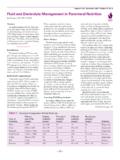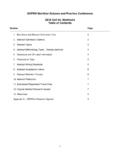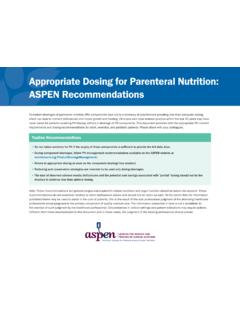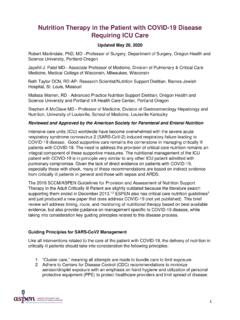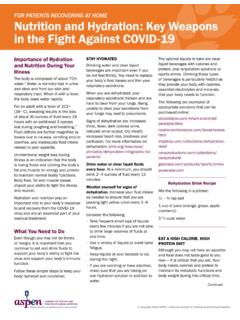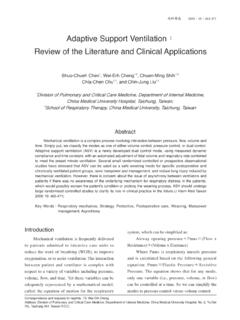Transcription of Nutrition in Clinical Practice - ASPEN
1 In Clinical Practice online version of this article can be found at: DOI: 2005 20: 625 Nutr Clin PractMichael D. Kraft, Imad F. Btaiche and Gordon S. SacksReview of the Refeeding Syndrome Published by: behalf of: The American Society for Parenteral & Enteral Nutrition can be found at: Nutrition in Clinical PracticeAdditional services and information for Alerts: : : : What is This? - Dec 1, 2005 Version of Record >> by Karrie Derenski on March 19, from Invited ReviewReview of the Refeeding SyndromeMichael D. Kraft, PharmD* ; Imad F. Btaiche, PharmD, BCNSP* ; andGordon S. Sacks, PharmD, BCNSP *Department of Clinical Sciences, College of Pharmacy, University of Michigan, Ann Arbor, Michigan; Department ofPharmacy Services, University of Michigan Health System, Ann Arbor, Michigan; and the Pharmacy PracticeDivision, School of Pharmacy, University of Wisconsin Madison, Madison, WisconsinABSTRACT:Refeeding syndrome describes a constella-tion of metabolic disturbances that occur as a result ofreinstitution of Nutrition to patients who are starved orseverely malnourished.
2 Patients can develop fluid andelectrolyte disorders, especially hypophosphatemia, alongwith neurologic, pulmonary, cardiac, neuromuscular, andhematologic complications. We reviewed literature onrefeeding syndrome and the associated electrolyte abnor-malities, fluid disturbances, and associated addition to assessing scientific literature, we also con-sidered Clinical experience and judgment in developingrecommendations for prevention and treatment of refeed-ing syndrome. The most important steps are to identifypatients at risk for developing refeeding syndrome, insti-tute Nutrition support cautiously, and correct and supple-ment electrolyte and vitamin deficiencies to avoid refeed-ing syndrome.
3 We provide suggestions for the preventionof refeeding syndrome and suggestions for treatment ofelectrolyte disturbances and complications in patientswho develop refeeding syndrome, according to evidence inthe literature, the pathophysiology of refeeding syndrome,and Clinical experience and termrefeeding syndrome(RS) is generallyreserved to describe the metabolic alterations thatoccur during Nutrition repletion of underweight,severely malnourished, or starved individuals. Thehallmark sign of RS is severe hypophosphatemiaand its associated complications. However, RS actu-ally encompasses a constellation of fluid and electro-lyte abnormalities affecting multiple organ systems,including neurologic, cardiac, hematologic, neuro-muscular, and pulmonary function.
4 This article willreview the pathophysiology of RS, its physiologiccomplications, the treatment of associated metabolicdisturbances, and provide guidelines for its recogni-tion and classic study describing RS was conducted byKeys and colleagues1in 1944 on male conscientiousobjectors of World War II. The participants hadundergone semistarvation for 6 months and uponnutrition replenishment, some subjects developedcardiac failure. With the advent of modern-day par-enteral Nutrition (PN) and enteral Nutrition (EN),reports of similar complications were noted inseverely undernourished patients who receivedaggressive Nutrition supplementation.
5 Weinsier andKrumdieck2reportedcardiopulmonaryfail ureresulting in death of 2 chronically undernourishedwomen who received aggressive PN. Both patientswere well below ideal body weight (IBW; 40% and70%, respectively) and exhibited low serum concen-trations of potassium and phosphorus before PNinitiation. Large amounts of carbohydrate and pro-tein were delivered (approximately 75 kcal/kg fromdextrose and g/kg of protein) at PN initiation,rather than gradually increasing PN calories to goalover the following days. Within 48 hours, bothpatients experienced cardiac abnormalities and pul-monary failure requiring mechanical hypophosphatemia, hypokalemia, and hypo-magnesemia occurred despite the presence of sup-plemental electrolytes in the PN formulations.
6 Onepatient died on hospital day 6 and the other diedduring the third week of hospitalization. These out-comes represent the most severe responses torefeeding but underscore the importance of under-standing this syndrome, recognizing patients atrisk, and providing appropriate treatment in theevent of its of Refeeding SyndromeStarvationUnderstanding the physiology of starvation pro-vides insight into the morbid sequelae associatedwith refeeding a severely undernourished individ-Correspondence: Michael D. Kraft, PharmD, Clinical AssistantProfessor and Clinical Pharmacist, University of MichiganHealth System, Department of Pharmacy Services, UH/B2 D301,Box 0008, 1500 East Medical Center Drive, Ann Arbor, MI48109-0008.
7 Electronic mail may be sent to in Clinical Practice 20:625 633, December 2005 Copyright 2005 American Society for Parenteral and Enteral Nutrition625 by Karrie Derenski on March 19, from ual. During the initial period of starvation (24 72hours), the liver uses glycogen stores for energy andskeletal muscle to provide amino acids as a sourcefor new glucose production (ie, gluconeogenesis) forglucose-dependent tissues, such as the brain, renalmedulla, and red blood cells. After 72 hours ofstarvation, metabolic pathways shift to deriveenergy from ketone production as a result of freefatty acid oxidation while sparing protein mobiliza-tion from skeletal adaptive mecha-nisms include an overall decrease in liver gluconeo-genesis, a decline in basal metabolic rate, reductionin the secretion of insulin, and an increased use offree fatty acids by the brain as the primary energysource in place of the reintroduction of carbohydrateviaoralfeeding, EN, or PN, there is a sudden shift back toglucose as the predominant fuel source.
8 Creating ahigh demand for the production of phosphorylatedintermediates of glycolysis (ie, red blood cell adeno-sine triphosphate [ATP] and 2,3-diphosphoglycerate[DPG]) with inhibition of fat metabolism. Thisresults in hypophosphatemia, the hallmark sign ofRS. Additional mechanisms identified as contribut-ing to low serum phosphorus concentrations includepreexisting low total body stores of phosphorus dur-ing starvation and enhanced cellular uptake of phos-phorus during anabolic refeeding. Phosphate is nec-essary for accrual of lean tissue mass and is a vitalcomponent of metabolic pathways involving the pro-duction of ATP and 2,3-DPG. Potassium and mag-nesium also shift intracellularly in response toanabolism and increased insulin release.
9 Magne-sium is a cofactor for the Na-K ATPase pump, souncorrected hypomagnesemia can complicate potas-sium repletion. Other metabolic alterations thatmay occur include fluid imbalance and vitamin defi-ciencies. An expansion of the extracellular watercompartment occurs during refeeding of the mal-nourished individual. Although the exact mecha-nism of fluid imbalance in RS is unknown, sodiumand water retention may be due to an antinatri-uretic effect from hyperinsulinemia4or a possibleinteraction between the water, sodium, and carbo-hydrate it is difficult todetermine whether thiamine deficiency is a result ofRS or is a preexisting deficiency due to starvation, itis reasonable to presume that an undernourishedindividual is at risk for thiamine deficiency.
10 Thia-mine is an essential cofactor involved in the metab-olism of phosphorylated form ofglucose is converted to pyruvate, which undergoesdecarboxylation in the presence of pyruvate dehy-drogenase and thiamine. Acetyl coenzyme A is pro-duced for entrance into the Krebs cycle and genera-tion of ATP as an energy source for all living doses of carbohydrate can increase the demandfor thiamine use in undernourished subjects withdecreased baseline thiamine stores, thus precipitat-ing thiamine deficiency and its associated a result, thiamine administration prior toand during carbohydrate intake is recommended inpatients at risk for ManifestationsClinical manifestations of RS are related to theelectrolyte and vitamin deficiencies that are presentand the subsequent abnormalities that develop withthe initiation of Nutrition support.

